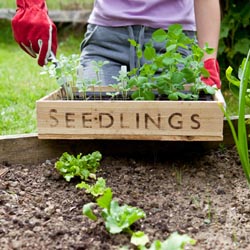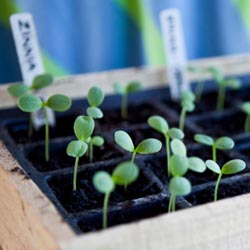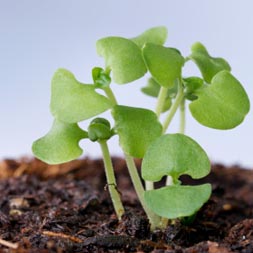Seedlings can be purchased of course but, for a number of reasons, you may wish to start your own plants. By starting plants from seed, you have a much greater selection of flowers, vegetables and herbs to choose from. Old time favorites and less common varieties might not be available as plants but are readily available in seed. We offer an extensive selection including many hard-to-find, unusual, organic, non gmo and heirloom seed varieties.
CONTAINERS
Traditionally, seeds are started directly in flats or in peat pot and seed starting tray place into the flat. We carry a wide assortment of sizes and styles of these classic items as well as the ever popular Jiffy-7 wafer. When moistened, the Jiffy-7 expands to form a small, self-contained pot of soil into which seed is sown and, later, may be directly planted in the garden. This is an excellent choice for plants that do not like their roots disturbed during transplanting.
SOIL
It is best to use a light, soilless planting medium labeled as a “Seed Starting Mix”. These mixes are sterile and contain adequate nutrients to carry seedlings through until it’s time for transplanting. Never use garden soil, it is too heavy, causing poor germination, and may also introduce a fatal fungal disease called “damping off”.
SOWING
Seeds should be sown 2 to 10 weeks before the last spring frost date. Your seed packet will provide this information. Fill your containers to the top with moist growing medium. Tamp your container gently, but firmly, on the table top to remove air pockets. Add more mix as needed to bring it the soil back to the top and smooth the surface flat. Larger seeds are generally planted deeper than small seed. Your seed packet will advise the planting depth. Gently press the seeds into the mix or simply set them on the surface of the soil and place milled sphagnum moss over the top to prevent damping off. Cover the flat with a clear humidity dome. Be sure to label your containers with plant markers and include the plant name and date sown.
TEMPERATURE
Many seeds require warm soil in order to germinate. You can accomplish this by using a heat mat, heat tray or heating cable. Flats may also be placed on top of the refrigerator or a hot water heater. Do not place seed-starting trays on a windowsill as early-season nighttime temperatures are frequently too cool to promote good germination. Once green is visible above the soil heating should cease.
MOISTURE
Seeds need to be kept constantly moist in order to germinate. Moisten the soil thoroughly before planting. Water again when the soil surface is dry. Watering from below is the best method. You may also water from above using superfine nozzle or plastic spray bottle until the soil is saturated. The medium should stay constantly moist but not soggy. It is important not to overwater but also not to permit the flats to dry out. Once seedlings have grown a half-inch or so, you should water less frequently allowing the soil dry slightly between waterings.
LIGHT
Seedlings will also need light and the best method is to use the traditional fluorescent fixtures or the new energy saving LEDs. Suspend lights just an inch or two away from the plants. Lights must be on at least 14 to 16 hours a day. As your seedlings grow, raise the lights accordingly. If your seedlings do not get enough light, they will become weak and spindly.
FERTILIZING
Fertilize seedlings weekly using a half-strength solution of a complete organic fertilizer. A fish and seaweed blend works well. Thin seedlings if they become overcrowded.
HARDENING OFF & PLANTING OUT
Seedlings may be moved outside after all danger of frost has passed. Move your trays outside gradually over a five to seven day period. Start by putting them out for a few hours, and then gradually increase the duration until they are left out all day and night. Keep them in a lightly shaded, protected spot during the day to prevent sunburn. Continue to monitor soil moisture and water as necessary. After you have “hardened off” your seedlings, gently transplant them into the garden. Try not to handle the root ball too much as they are quite fragile. Water thoroughly after transplanting and again every day for about a week. Newly set out plants will look sparse at first, but they are resilient and will grow and fill in quickly!









